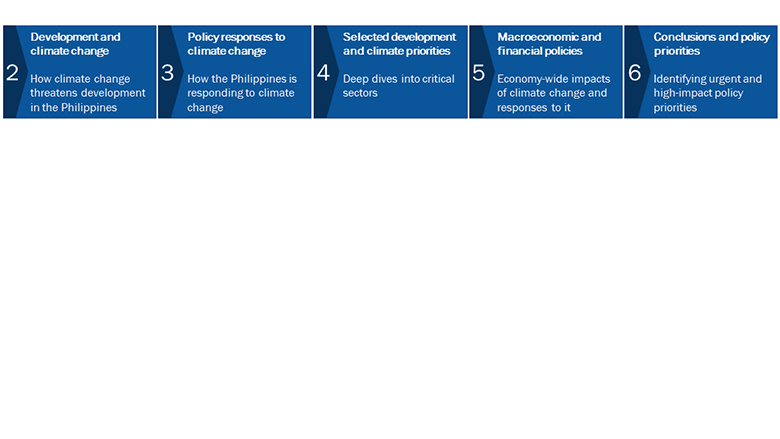Download the Philippines Country Climate and Development Report (CCDR)
Background Papers: Climate Change Institutional Analysis | Water | Agriculture | Energy Transition | Transport | Macroeconomic Modelling | Climate Change and Environmental Risks in the Financial and Private Sector | The Distributional Impacts of Climate Change Damage, Adaptation and Mitigation Policies | Strengthening Adaptive Social Protection | Social Impacts of Climate Change in High-Risk Areas | Disaster Risk Management
Climate change poses major risks for development in the Philippines. Climate shocks, whether in the form of extreme weather events or slow-onset trends—will hamper economic activities, damage infrastructure, and induce deep social disruptions. Policy inaction would impose substantial economic and human costs, especially on the poor.
The Philippines Country Climate and Development Report (CCDR) comprehensively analyzes how climate change will affect the country's ability to meet its development goals and pursue green, resilient, and inclusive development. The CCDR helps identify opportunities for climate action by both the public and private sectors.
The CCDR shows that climate change poses major risks to development in the Philippines but that the country has many options to address them. If nothing is done, climate change will impose substantial economic and human costs, reducing GDP by as much as 13.6 percent of GDP by 2040, with the poorest households most affected. These effects are likely to vary across and within regions. Adapting to the risks of climate change—including extreme events and slow-onset problems—is critical for the Philippines. It cannot wholly eliminate the costs of climate change, but it can greatly reduce them. Many adaptation responses also contribute to mitigation; conversely, many mitigation measures generate local co-benefits, such as reduced air pollution.
Although the Philippines is a relatively low emitter of Greenhouse gases (GHGs), it can contribute to global mitigation efforts through an energy transition, including a transition away from coal. The investment costs of such adaptation measures and energy transition are substantial but not out of reach. A large part of decarbonizing the power system has a relatively low incremental system cost compared with the Government’s current plan, mainly involving further expanding renewables such as solar, whose cost is declining. Moreover, it could lead to lower electricity prices. The energy transition should be complemented with energy efficiency measures—notably in transport and buildings—and by encouraging compact city development to facilitate mass transit. The private sector drives economic growth and is pivotal in adaptation and mitigation. As such, appropriate incentives must be in place.
The CCDR prioritizes the most urgent development challenges likely to be impacted by climate change in the Philippines. Even among these, the analysis is necessarily brief. Background papers prepared for the CCDR consider a much broader range of issues and examine them in more detail than is possible here.
Chapter 2 examines the challenges climate change poses for development in the Philippines.
Chapter 3 then assesses the country’s NDCs and its existing climate policies.
Chapter 4 details the sectors and locations most exposed to climate change, examining the likely impacts on economic activities in these sectors and the people who depend on them. The analysis in this chapter relies on a synthesis of prior work complemented, in several instances, on detailed partial-equilibrium modeling prepared specifically for the CCDR.
Chapter 5 combines these analytical strands and uses Computable General Equilibrium (CGE) models to assess the impact of climate shocks and climate policy tradeoffs on growth, inequality, and poverty.
Chapter 6 summarizes policy recommendations for all key sectors and identifies policy priorities.
